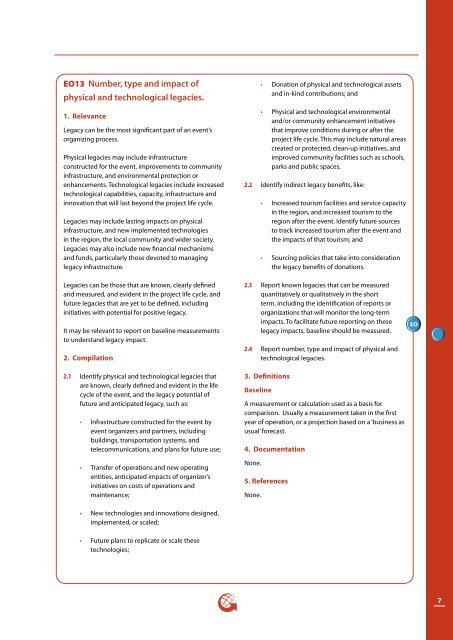Event Organizers Sector Supplement - Global Reporting Initiative
Event Organizers Sector Supplement - Global Reporting Initiative
Event Organizers Sector Supplement - Global Reporting Initiative
You also want an ePaper? Increase the reach of your titles
YUMPU automatically turns print PDFs into web optimized ePapers that Google loves.
EO13 Number, type and impact of<br />
physical and technological legacies.<br />
1. Relevance<br />
Legacy can be the most significant part of an event’s<br />
organizing process.<br />
Physical legacies may include infrastructure<br />
constructed for the event, improvements to community<br />
infrastructure, and environmental protection or<br />
enhancements. Technological legacies include increased<br />
technological capabilities, capacity, infrastructure and<br />
innovation that will last beyond the project life cycle.<br />
Legacies may include lasting impacts on physical<br />
infrastructure, and new implemented technologies<br />
in the region, the local community and wider society.<br />
Legacies may also include new financial mechanisms<br />
and funds, particularly those devoted to managing<br />
legacy infrastructure.<br />
• Donation of physical and technological assets<br />
and in-kind contributions; and<br />
• Physical and technological environmental<br />
and/or community enhancement initiatives<br />
that improve conditions during or after the<br />
project life cycle. This may include natural areas<br />
created or protected, clean-up initiatives, and<br />
improved community facilities such as schools,<br />
parks and public spaces.<br />
2.2 Identify indirect legacy benefits, like:<br />
• Increased tourism facilities and service capacity<br />
in the region, and increased tourism to the<br />
region after the event. Identify future sources<br />
to track increased tourism after the event and<br />
the impacts of that tourism; and<br />
• Sourcing policies that take into consideration<br />
the legacy benefits of donations.<br />
Legacies can be those that are known, clearly defined<br />
and measured, and evident in the project life cycle, and<br />
future legacies that are yet to be defined, including<br />
initiatives with potential for positive legacy.<br />
It may be relevant to report on baseline measurements<br />
to understand legacy impact.<br />
2. Compilation<br />
2.1 Identify physical and technological legacies that<br />
are known, clearly defined and evident in the life<br />
cycle of the event, and the legacy potential of<br />
future and anticipated legacy, such as:<br />
• Infrastructure constructed for the event by<br />
event organizers and partners, including<br />
buildings, transportation systems, and<br />
telecommunications, and plans for future use;<br />
• Transfer of operations and new operating<br />
entities, anticipated impacts of organizer’s<br />
initiatives on costs of operations and<br />
maintenance;<br />
2.3 Report known legacies that can be measured<br />
quantitatively or qualitatively in the short<br />
term, including the identification of reports or<br />
organizations that will monitor the long-term<br />
impacts. To facilitate future reporting on these<br />
legacy impacts, baseline should be measured.<br />
2.4 Report number, type and impact of physical and<br />
technological legacies.<br />
3. Definitions<br />
Baseline<br />
A measurement or calculation used as a basis for<br />
comparison. Usually a measurement taken in the first<br />
year of operation, or a projection based on a ‘business as<br />
usual’ forecast.<br />
4. Documentation<br />
None.<br />
5. References<br />
None.<br />
EO<br />
• New technologies and innovations designed,<br />
implemented, or scaled;<br />
• Future plans to replicate or scale these<br />
technologies;<br />
7

















